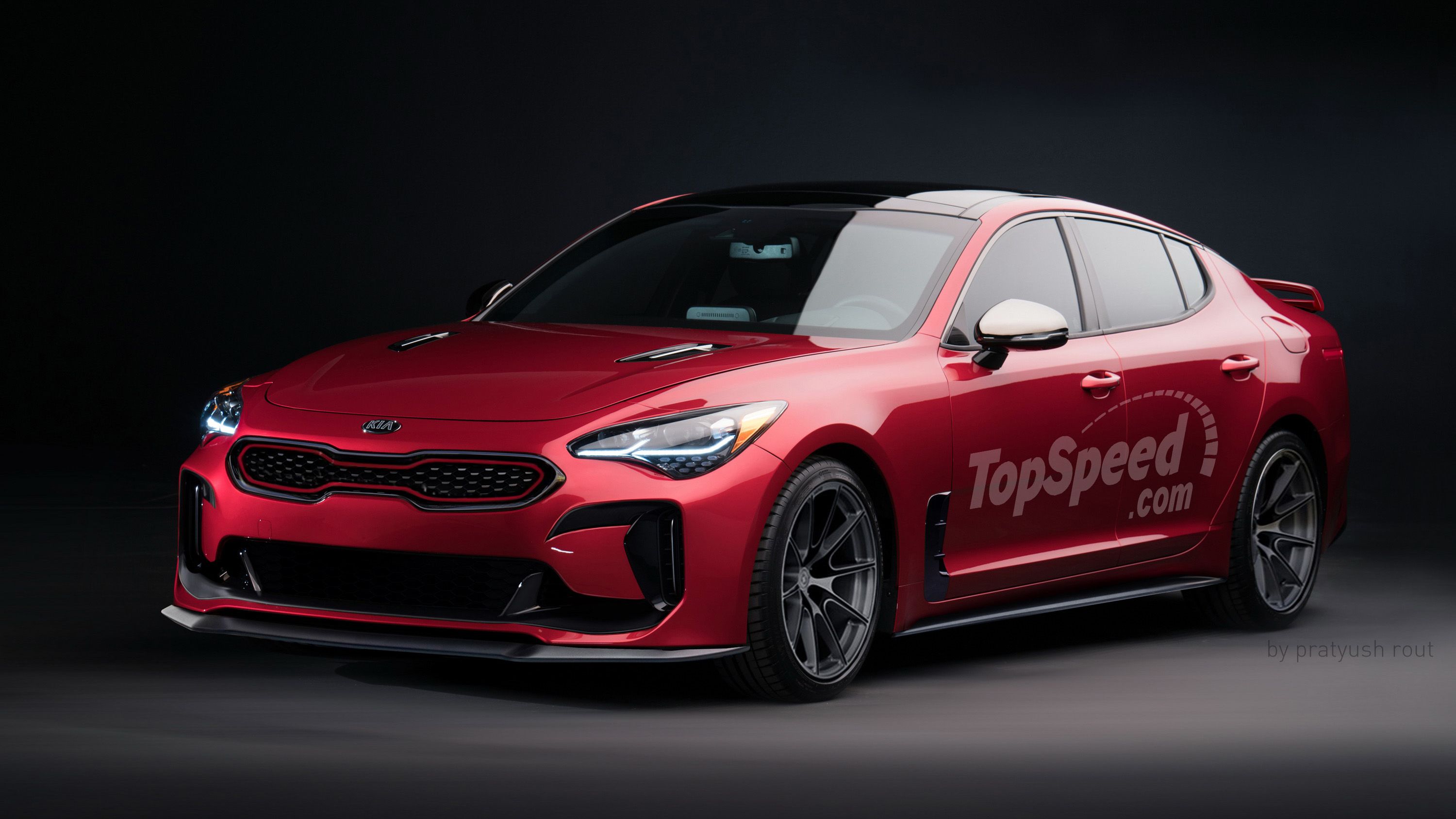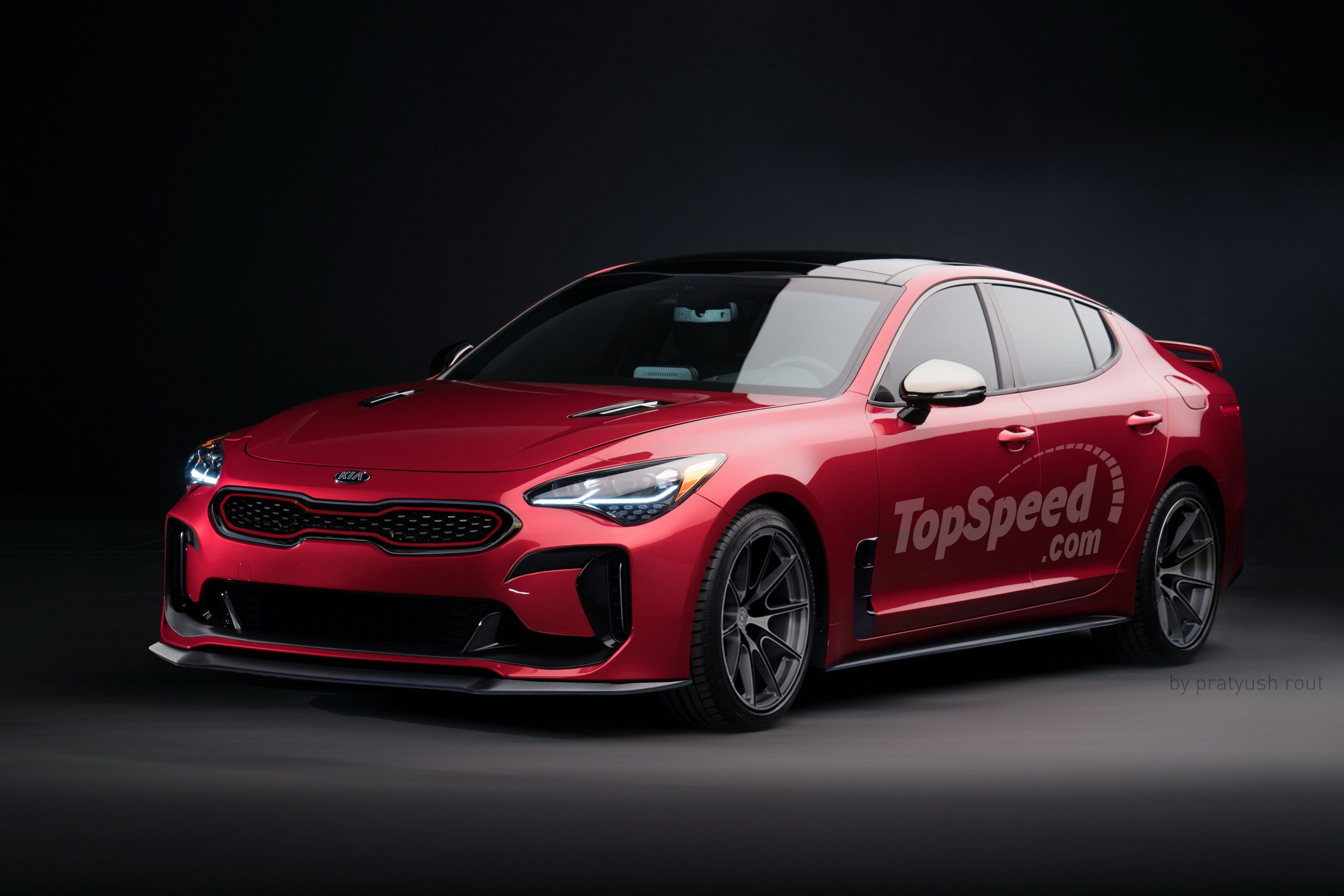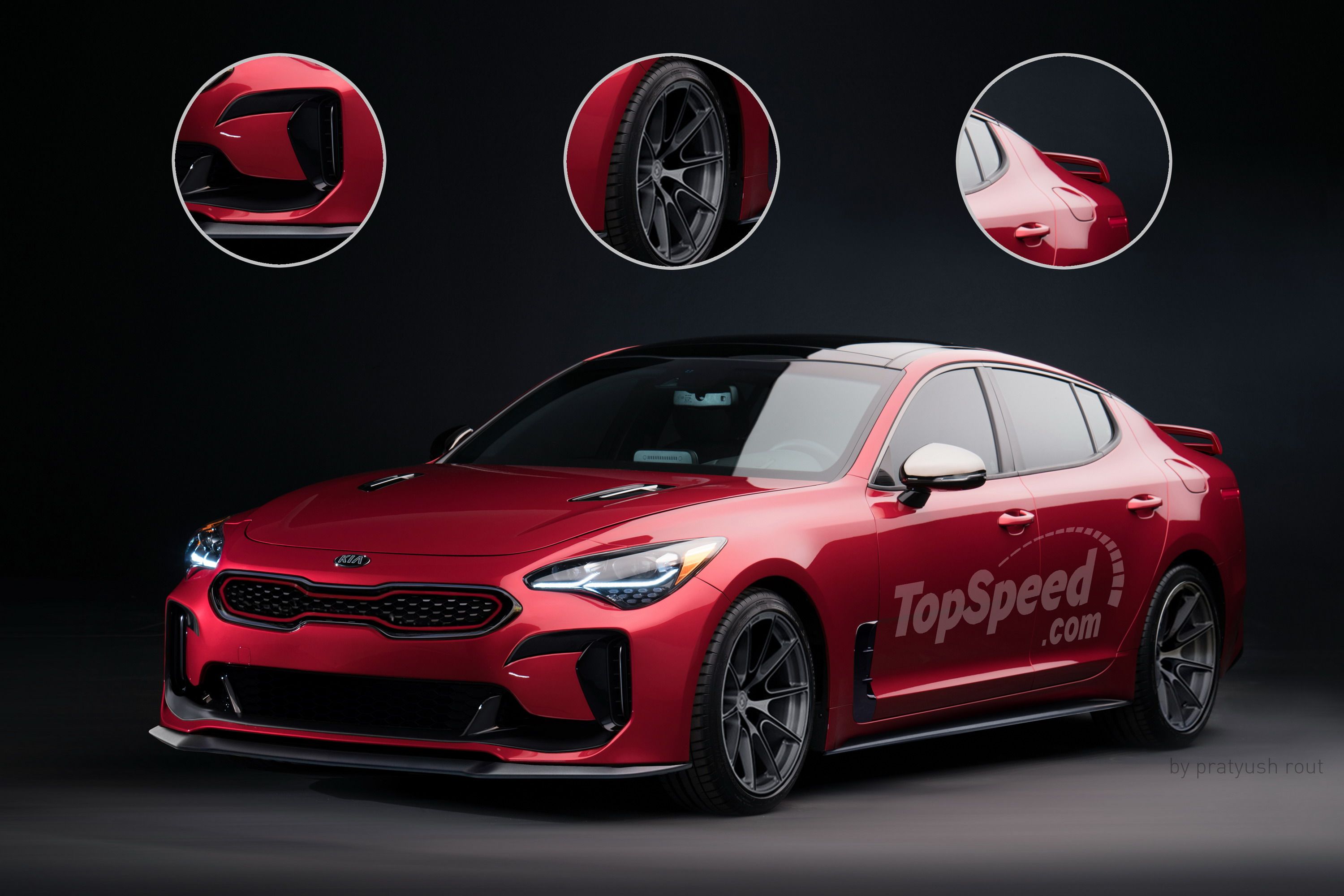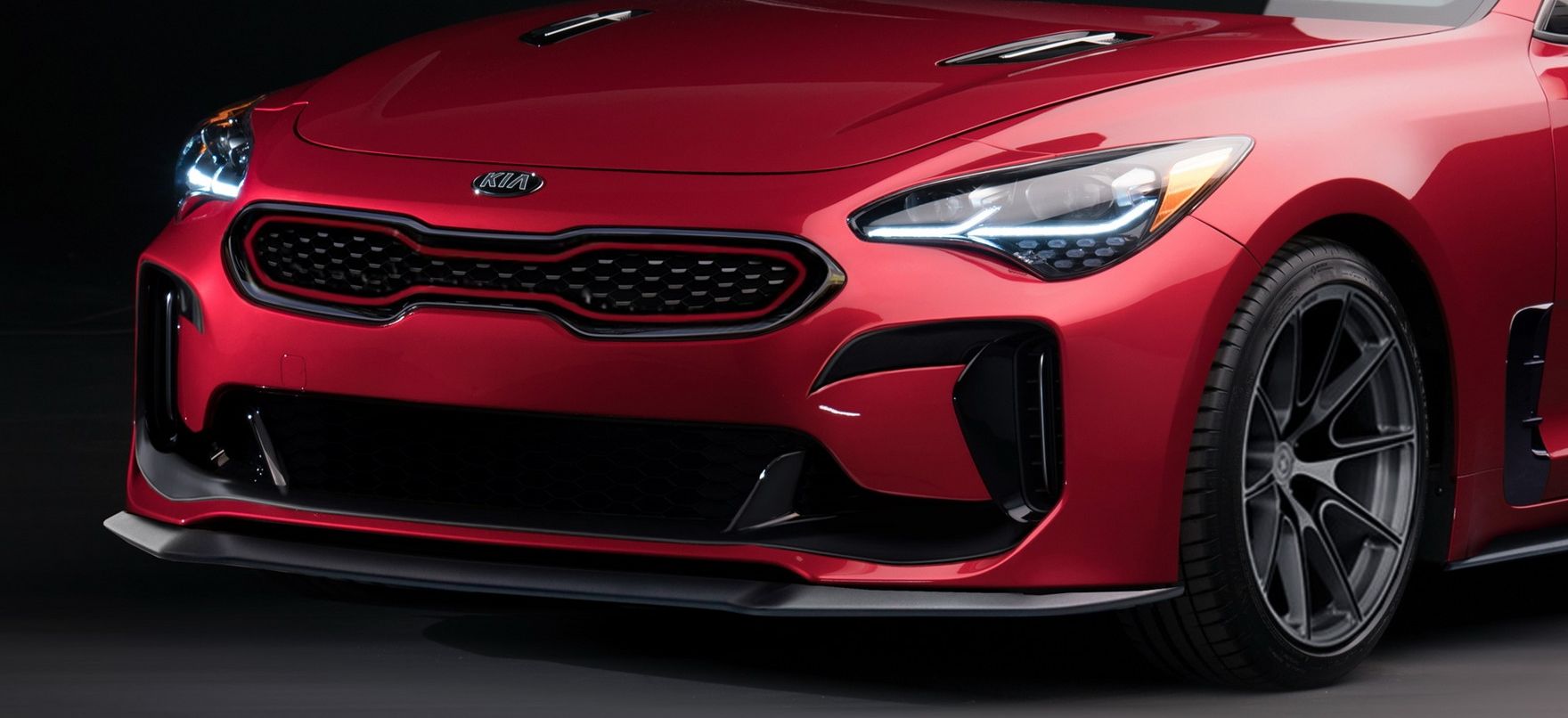Kia surprised a lot of people when it debuted its new Stinger GT thanks to the performance and luxury DNA that Kia developed for its first big step into such a popular segment. Set to compete against models like the Audi A5 Sportback, Mercedes C-Class, BMW 3 Series GT, and the BMW 4 Series Gran Coupe, Kia’s new halo car has a lot to live up to. But, Kia isn’t done writing the Stingers story just yet as Product Market Boss, Spencer Cho, has said that the Stinger will become electrified in the future. Meanwhile, a high-performance version could be on the table as well, thanks to the Stinger’s excessively strong chassis. With that concept in mind, we tapped into our resident artist to put together a rendering of what a high-performance Stinger just might look like.
As a high-performance model, Kia will build on the car’s current profile by adding more aggressive features on the outside, to go with a few minor updates inside, and a significant power bump under the hood. It’s pretty likely that it will eventually happen, but what we don’t know is what Kia will do to increase the performance of the Stinger. Will its future hybrid plans play a role in the performance model or will it be all computer remapping and hardware upgrades? Well, we have a few theories, so let’s talk a little more about the rendering and the possibilities in my speculative review below.
2019 Kia Stinger GT Plus
- Make: Array
- Model: 2019 Kia Stinger GT Plus
- [do not use] Vehicle Model: Array
Exterior
A Stinger as we know it now is already pretty aggressive, but there’s a little room to grow in this department if it will stand out among the other Stinger models. To start off, it will receive a new pair of fascias. Up front, this means that we’ll see an updated grille design that includes a black surround with body-colored outlining on the inside edge. Down below, the design of the fascia will result in a new cutout for the air dam that makes way for a larger insert that links the corner vents together. Those little winglets on the edges of the air dam will remain, but we’ll also see the addition of a mild splitter to help increase downforce in the front and emphasize the car’s aggressive nature. Those vents on the hood could also be functional the high-performance model, allowing for better engine bay cooling at higher speeds.
Moving over to the sides, there won’t be a lot of change, but expect to see a few different wheel options and high-performance tires. It could, in theory, get a set of sleeker side view mirrors to help reduce drag. The side skirts will see the addition of some new cladding that matches that of the front splitter and provides a bit of downforce on the sides. That vent on the fender should be painted to match the rest of the body kit. We’ve left the vent looking the same outside of color, but Kia could up the ante a bit with a more aggressive insert.
Around back, the high-performance Stinger should get a sporty wing that will be more about appearance than anything but could offer a bit of rear downforce at higher speeds. The rear fascia should see some changes as well, but the most prominent change will be the addition of a more aggressive and pronounced diffuser to go with slightly larger exhaust pipes. Kia could also more the exhaust outlets closer to the center to give some more character in the rear, which would be a nice touch if it’s done correctly. Overall ride height could drop by as much as a half inch.
Interior
Note: Standard Kia Stinger pictured here.
Inside, I wouldn’t expect too much to change, but that’s okay because the Stinger already comes correct with a very comfortable and luxurious cabin. The high-performance model will likely get a flat-bottom steering wheel with Alcantara wrapping, while certain trim inserts will likely come in carbon fiber. The seats are already pretty sporty but could be updated to offer even more support and the use of five-point racing harnesses. Considering Kia doesn’t believe that there is very much demand for a manual transmission, I wouldn’t expect to see a manual shifter, but the paddle shifters will carry over. On the technology front, I suspect Kia could introduce an all-digital instrument cluster that rivals that of Audi’s virtual cockpit. The infotainment display could grow as well considering there is room to breathe on each side of the current unit. The option for an even better sound system could be available as well, but the real kicker will come from under the hood, so let’s move on for now.
Drivetrain
This is the section where things are really clouded with a mysterious fog that could leave us all surprised when Kia finally drops the high-performance bomb that we’re all waiting for. We know that the Stinger’s chassis can support more power than what is currently offered by the 3.3-liter V-6 but, outside of that, there’s no telling what Kia will do to generate more power. One possibility is that the 3.3-liter will see larger turbos or at least increased boost pressure. An ECU remapping could also lead to a significant jump in power, but how much power Kia can squeeze out of that V-6 remains to be seen. With the current range-topping model generating 365 horsepower and 376 pound-feet, an increase to as much as 430 horsepower and 420 pound-feet isn’t necessarily out of the question. Of course, that’s assuming that 3.3-liter can maintain reliability with that much power on tap.
But, there’s something else to consider too. When Spencer Cho, Kia’s overseas marketing boss, spoke to Autocar shortly after the Stinger’s debut, he told them that it would eventually see electrification in future which will bring hybrid technology to the halo car. So, Kia could manage to up the power output with the use of an electric motor and a battery pack. How this would happen is hard to say, but the car could maintain its current powertrain layout with an electric motor adding to the power output sent to the rear wheels or all four. It’s also possible that Kia could, somehow, take the rear-wheel-drive model and throw a dedicated pair of motors up front to drive the front wheels. With the help of an electric motor that supplements power to all fours, the Stinger could gain an extra hundred ponies. But, with the second configuration I mentioned, power output could be dramatically increased with the engine’s power split between the rear wheels and each motor up front delivering 100-plus horsepower, ultimately leading to the possibility of the Stinger approaching as much as 500 horses.
Then again, considering Kia left the door open for a potential all-electric model in the future, maybe the high-performance Stinger will be an all-electric beast. An all-electric model would battle with the Tesla Model S, but with enough range and output, it could still compete with gasoline-powered models like the M3 and Mercedes C63, among others. Plus, without an ICE up front, there’s plenty of room for the battery packs. After all, Kia could tap into a company Kreisel Electric for an all-electric battery setup. That company is a start-up that is doing wonders for cars that weren’t originally designed to be powered by batteries as shown off in its recent conversion to a Mercedes G-Class that Arnold Schwarzenegger is driving around California right now.
Of course, that’s all speculation, and who knows if the chassis of the stinger could even support dual motors up front as I’ve mentioned or if Kia has any ambition to really bust into the all-electric segment with the stinger, but that’s the fun of speculation – you never know. Regardless of what Kia does to make the high-performance Stinger a reality, there’s one thing we know for sure after seeing the new Stinger: Kia knows how to do things right. So, there’s no doubt that the high-performance stinger will be ready to impress. We just have to wait for Kia to make it happen. Here’s to hoping it happens sooner than later.
Current Model Specifications
|
Kia Stinger |
Kia Stinger GT |
Kia Stinger Diesel (Europe only) |
|
|
Engine |
2.0L Turbo Charged I4 Theta II |
3.3L Twin Turbo V6 Lambda II |
2.2-litre turbodiesel |
|
Horsepower (est.) |
255 HP @ 6,200 RPM |
365 HP @ 6,000 RPM |
197 HP @ 3,800 RPM |
|
Torque (est.) |
260 LB-FT @ 1,400-4,000 RPM |
376 LB-FT @ 1,300-4,500 RPM |
325 LB-FT @ 1,750-2,750 RPM |
|
Transmission |
8-speed automatic |
8-speed automatic |
8-speed automatic |
|
Front suspension |
MacPherson |
MacPherson |
MacPherson |
|
Rear suspension |
Multi Link (5-link) |
Multi Link (5-link) |
Multi Link (5-link) |
|
0 to 60 mph |
6 seconds (est.) |
5.1 seconds |
8.5 seconds |
|
Top Speed |
155 mph (est.) |
168 mph |
140 mph |
Pricing
Considering the fact that pricing for the current models is still a mystery, there’s no way of knowing what kind of price point the high-performance model will have. With the entry-level Stinger expected to start out around $35,000 and the 3.0-liter model expected to start around $40,000, a high-performance version could start out as low as $45,000 or as high as $50,000 depending on what it offers and how it is configured. Either way, Kia will most definitely make sure to keep its price point below that of the competition to give it an even strong edge on the market.
Competition
BMW M3
When Kia unleashes a high-performance Stinger, it will have the proper credentials to compete with the BMW M3. Sporty and dynamic, the M3 is the definition of German performance and is a tough competitor for any model in the same segment. It offers up 425 horsepower and 406 pound-feet of torque from a 3.0-liter inline-six, which is enough to push the little M up to 60 mph in 4.1 seconds with a manual or 3.9 seconds with an automatic transmission. Top speed is electronically limited to 155 mph. There’s no telling how well the high-performance Stinger will actually compete, but you can bet Kia will find a way to make it just as fast, if not faster, to 60 while top speed should well exceed the 155 mph top speed offered by the M3. Furthermore, the HP Stinger’s updated exterior and interior will bring it up to par with that of the M3 as well, and with the M3 starting out at $64,000 as of the time of this writing, it should have a pretty huge advantage on the pricing front as well.
Read the full review here.
Read the full review here.0
While the C-Class is only available as a full-fledged sedan, it’s still a viable competitor for the Stinger, and when it comes to the high-performance Stinger, the C43 should float the bill as a worthy competitor. Powered by an AMG-
enhanced 3.0-liter V-6, it offers up 362 horsepower and 384 pound-feet of torque. That’s enough to put it to 60 mph in 4.6 seconds with top speed limited to 155 mph. Its price point at the time of this writing falls just north of $50,000 at $52,000 before options, so it’s right in line as far as pricing goes. Then again, if Kia really ups the performance figures of the Stinger, then you’ll have to look to the $65,200 C63 sedan that is powered by a handcrafted AMG 4.0-liter V-8 with 469 horsepower and 479 pound-feet of torque. That will bring its 60-mph sprint down to 4.0-seconds flat, which is where the HP Stinger is expected to reside. Again, the Stinger will likely beat out the C43 and C63 in the top speed department, so any showdown between the two better happen in the quarter-mile if the Merc is going to stand a chance.
Read the full review here.
Tesla Model S
If Kia really does bring an all-electric variant of the Stinger to market as a high-performance model, then it’s main competitor will be the Tesla Model S. It can be had in rear-wheel or all-wheel drive and can cover a maximum range of 351 miles in 100D form. The P100D comes in a little lower at 337 miles of range, but it can hit 60 mph in as little as 2.5 seconds. Of course, this would be tough for Kia to tackle with the first all-electric version of the Stinger, but if the past couple of years has taught us anything, it’s that anything can happen. Currently, the entry-level 60 model will set you back $68,000 while the range-topping P100D will hit the bank for as much as $134,500, which brings me to my point. If Kia can bring an all-electric Stinger to the market that can compete with any of these Tesla models, it will undoubtedly be cheaper and will pose a huge threat to the brand that set the standard for all-electric range and usability.
Read the full review here.
Conclusion
And there you have it. There’s a lot of speculation here, but that’s what makes it so fun. The Kia Stinger is positioned to be an awesome template for other vehicles from the brand, but also for more insane iterations of itself that could really rattle the cage of more expensive models from BMW, Mercedes, Audi, and even other luxury brands like Lexus and Acura. But, only time will tell what Kia can actually pull off, so for now, we just have to sit back and wait. In the meantime, we’re hoping to get our hands on the Stinger GT in the future and can’t wait to put it through the paces to see what it’s really about when the rubber meets the pavement. What do you think of what I’ve said here? Am I too optimistic or is the sky really the limit for the Stinger? Let’s talk about it in the comments section below.








